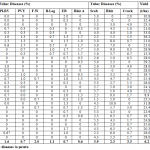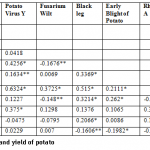Research Article
Prevalence of different foliar and tuber diseases on different varieties of potato
Sher Muhammad*1, Muhammad Shahbaz1, Muhammad Iqbal1, Arfan Sarwar Wahla1, Qurban Ali2, Muhammad Tasdiq Hussain Shahid1, Muhammad Shafiq Tariq1
Adv. life sci., vol. 1, no. 1, pp. 64-70, November 2013
*Corresponding author: Sher Muhammad (Email: sher1325@hotmail.com)
Author Affiliations
2-Department of Plant Breeding and Genetics, University of Agriculture Faisalabad – Pakistan
Abstract
Introduction
Methods
Results
Discussion
References
Abstract
Background: Potato is a starchy and tuberous crop from the perennial Solanum tuberosum of the Solanaceae family. The annually consumed diet of an average global citizen in the first decade of the 21st century included about 33 kg (73 lbs) of potato. Potato has become an important strategic vegetable crop of Pakistan. Therefore, potato health management has assumed new proportions which require continuous monitoring and mapping of the disease problems in the country.
Methodology: In this study thirty genotypes of potato were evaluated for resistance/tolerance against foliar and tuber diseases. The trial was conducted in accordance with randomized complete block design (RCBD) with three replications and the results were statistically analyzed. Different normal agronomic and plant protection measures were carried out in the crop. Data regarding disease incidence was recorded.
Results: Results indicated soil and seed borne diseases are most widespread and are likely to become major threat to potato production in Pakistan. Among these stem canker (Rhizoctonia solani) and black scurf, fusarium wilt and common scab (Streptomyces scabies) are major diseases and present in almost all production zones. Among viral diseases, potato leaf roll virus (PLRV) was the major disease. Mop top virus has been also found on some genotypes. Significant correlation was reported among emergence percentage, potato leaf roll virus, early blight of potato, black leg, potato virus Y (PVY), fusarium wilt, rhizocotonia and potato yield.
Conclusion: It was found that emergence percentage was significantly correlated with PLRV, PVY, fusarium wilt, rhizocotonia and potato yield while negative and significant correlation was reported for black leg and cracking. The significant correlations indicated that emergence was greatly affected by attack of different pathogens and potato yield also decreased due to loss of emergence.
Keywords: Solanum tuberosum, Stem canker, Black scurf, Fusarium wilt, Common scab, PLRV, PVY, Prevelance
Introduction
Potato is starchy, tuberous crop from the perennial Solanum tuberosum belonging to Solanaceae family. The word potato is refered to the plant itself in addition, the edible tuber. It is world's fourth largest food crop, following rice, wheat, and maize. The annually consumed diet of an average global citizen in the first decade of the 21st century included about 33 kg (73 lbs) of potato. Potato has become an important strategic vegetable crop of Pakistan. Therefore, potato health management has assumed new proportions which require continuous monitoring and mapping of the disease problems in the country. However, the local importance of potato is enormously variable and rapidly changing. It has always been an essential crop in Europe where production, per capita is still the highest in the world, but the most rapid development over the past few decades has occurred in southern and eastern Asia. China is now largest potato producing country all over the world, and nearly a third of the world's potatoes are harvested in China and India. There are number of diseases affecting potato crop, caused by fungi, bacteria, mycoplasma like bodies, viruses and nematodes. In Syria PVY, Potato virus S (PVS), Cucumber mosaic virus and Potato leaf roll virus were identified with infection rates of 54.2, 8.4, 3.7 and 0.9%, respectively. The overall rate of virus infection was as high as 72.9% in ware potato fields [1]. However, presence of a number of other potato diseases is also reported [2-4]. Weideman (1980) conducted a field survey of potato diseases in selected districts of Pakistan. This collaboration continues and providing valuable information. This study provides an overview of recent distributional trends of various potato diseases like, Potato leaf roll virus, Potato Virus Y, Fusarium Wilt, Black leg, Early Blight of Potato, Rhizoctonia A, scab, Rhizoctonia and cracking in Pakistan.
Methods
A total of 30 local strains/varieties of potato were evaluated for resistant/tolerant against foliar and tuber diseases at Potato Research Institute, Sahiwal. The material was sown on 09.10.2010, keeping a distance of plant to plant as 20 cm and row to row distances as 20 cm and 75 cm. The plot size was 7 x 0.75 m. The trial was conducted according to the RCBD with three replications and the results were analyzed statistically according to the formula given by Steel and Torrie (1980) [5]. Normal agronomic and plant protection measures were achieved in the crop. Data regarding disease incidence was recorded. For visual disease assessment, disease incidence was taken into account. Disease incidence was based on percentage of plants in a field or tubers in sample showing disease symptoms. Detailed results are presented in various reports about the potato diseases [6-10].
Results
Thirty (30) different strains were sown and checked the prevalence of different foliar and tuber diseases. In case of foliar diseases, FD49-28 found the maximum (2%) early blight followed by SH-5 (1.7%).
Similarly for Fusarium wilt (Fusarium oxysporum) and Black Leg (Erwinia corotovora) exhibited 0.7% on genotypes FD 35-36, FD 1-10 and 1% on genotype FD 49-28 respectively. In case of viral diseases on the basis of visual observation, the genotype FD 35-25 showed the maximum (2.3%) prevalence of PLRV followed by FD48-4 and FD 71-1 with 2.0 and 1.0% respectively. The genotype FD3-10 depicted 1.7% PVY. As regard tuber diseases FD3-9 had showed 5.3% common Scab followed by FD48-54 (5%). Similarly for black scurf (Rhizoctonia solani) 393619-44 exhibited maximum value 10.6% followed by SH-5 (9%) and for cracking FD48-54 had showed incidence 6.7% followed by FD71-1 (5.3%) (table 1).
It was found that among the foliar diseases fusarium wilt showed maximum value 0.7%. Similarly among the tuber diseases common scab was increasing in its distribution. Among viral diseases, PLRV remains the major disease. However, PVY and PVM were increasing. Mop top virus has been also found on some genotypes. It was found that significantly correlation reported among emergence percentage, PLRV, early blight of potato, black leg, PVY, fusarium wilt, rhizocotonia and potato yield. It was concluded that the attack of one disease may become the cause favorable conditions for other pathogens to attack and damage potato to decrease production.
Discussion
It was found from table 2 that Emergence percentage was significantly correlated with PLRV, PVY, fusarium wilt, rhizocotonia and potato yield while negative and significant correlation was reported for black leg and cracking. The significant correlations indicated that emergence was greatly affected by attack of different pathogens and potato yield also decreased due to loss of emergence [11]. PLRV was significantly correlated with PVY, early blight of potato, rhizocotonia A and rhizocotonia. Significant correlations indicated that the attack of pathogens was associated with each other and caused damage of potato tuber simultaneously [12]. PVY was significantly correlated with emergence percentage, PLRV, black leg, early blight of potato, rhizocotonia A and rhizocotonia. Significant correlations indicated that the attack of pathogens was associated with each other and caused damage of potato tuber simultaneously. Fusarium Wilt was significantly correlated with emergence percentage and rhizocotonia while negatively correlated with black leg and scab. Positive correlations indicated that pathogens attacked at same time but negative correlation showed that the attack of pathogens may cause to increase of decrease each other’s effect [13]. Black leg was significantly correlated with PVY, early blight of potato, early blight of potato, rhizocotonia A and cracking while negatively correlated with emergence percentage, fusarium wilt and potato yield. Positive correlation indicated that pathogens attacked at same time have positive effect on each other’s pathogencity against plant i.e. assisting each other for more severe attack. Early blight of potato was significantly correlated with PLRV, PVY, rhizocotonia A and scab. Positive correlation indicated that
the attack of early blight of potato make it favorable to other diseases to attack on the potato [14]. Rhizocotonia A as a foliar disease was significantly correlated with PVY, early blight of potato, early blight of potato, black leg, fusarium wilt and cracking. Scab was significantly correlated with early blight of potato, black leg, rhizocotonia and cracking while negatively and significantly correlated with potato yield [15]. Positive and significant correlations indicated that the attack of early blight of potato make it favorable to other diseases to attack on the potato and caused to decrease the yield of potato.
References
- Ali MC, Maoka T, Natsuaki K. The occurrence of potato viruses in Syria and the molecular detection and characterization of Syrian Potato virus S isolates. Potato Research, (2008); 51(2): 151-161.
- Mubin M, Briddon R, Mansoor S. Complete nucleotide sequence of chili leaf curl virus and its associated satellites naturally infecting potato in Pakistan. Archives of Virology, (2009); 154(2): 365-368.
- Peerzada S, Ahmad M, Dar G, Chattoo M, Bhat K. Evaluation of cultivars of potato (Solenum tuberosum) for disease reaction against late blight pathogen [Phytophthora infestans (Mont) de Bary]. International Journal of Current Microbiology and Applied Science, (2013); 2(9): 153-159.
- Shafique M, Javed N, Rasheed A, Arif MJ. Genetic response of some potato varieties against blackleg disease. Pakistan Journal of Phytopathology, (2010); 22(1): 16-19.
- Steel R, Torrie J. Principles and procedures of statistics: a Biometrical approach MCGraw-Hill Book Company Toronto. REDVET, (2012); 13(6): 481.
- Arif M, Ali M, Rehman A, Fahim M. Occurrence of potato mop-top virus in Northwest of Pakistan. European Journal of Plant Pathology, (2013); 1-10.
- Haynes KG, Wanner LA, Thill CA, Bradeen JM, Miller J, et al. Common scab trials of potato varieties and advanced selections at three US locations. American Journal of Potato Research, (2010); 87(3): 261-276.
- Merz U, Falloon R. Review: powdery scab of potato—increased knowledge of pathogen biology and disease epidemiology for effective disease management. Potato Research, (2009); 52(1): 17-37.
- Jamal A, Nasir IA, Tabassum B, Tariq M, Munim A, et al. Molecular characterization of capsid protein gene of potato virus X from Pakistan. African Journal of Biotechnology, (2012); 11(74): 13854-13857.
- Anwar M, Riaz A, Haque MI, Mughal SM. Occurrence and pathogenicity of common scab and soft rot potato in azad jammu and kashmir (PAKISTAN). Pakistan Journal of Phytopathology, (2013); 25(1): 15-22.
- Pecknold PC, Stevenson WR, Scott DH. A Compilation of Plant Diseases and Disorders in Indiana—1974; 2013. pp. 71-84.
- Fageria MS, Singh M, Nanayakkara U, Pelletier Y, Nie X, et al. Monitoring Current-Season Spread of Potato virus Y in Potato Fields Using ELISA and Real-Time RT-PCR. Plant Disease, (2013); 97(5): 641-644.
- Pasche J, Taylor R, David N, Gudmestad N. Effect of Soil Temperature, Injection Depth, and Metam Sodium Rate on the Management of Verticillium Wilt of Potato. American Journal of Potato Research, (2013); 1-14.
- Davis JA, Radcliffe EB, Thill CA, Ragsdale DW. Resistance to Aphids, Late Blight and Viruses in Somatic Fusions and Crosses of Solanum tuberosum L. and Solanum bulbocastanum Dun. American Journal of Potato Research, (2012); 89(6): 489-500.
- Palmer MW, Cooper J, Tétard-Jones C, Średnicka-Tober D, Barański M, et al. The influence of organic and conventional fertilisation and crop protection practices, preceding crop, harvest year and weather conditions on yield and quality of potato ( Solanum tuberosum) in a long-term management trial. European Journal of Agronomy, (2013); 4983-92.





